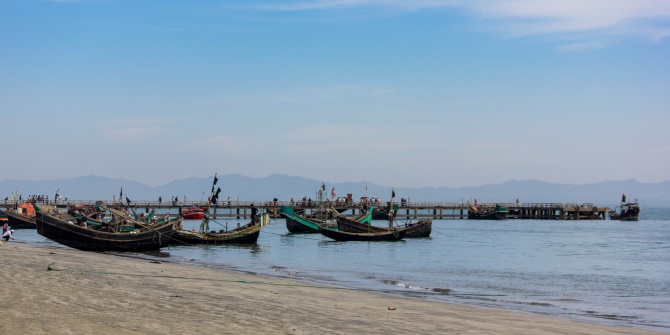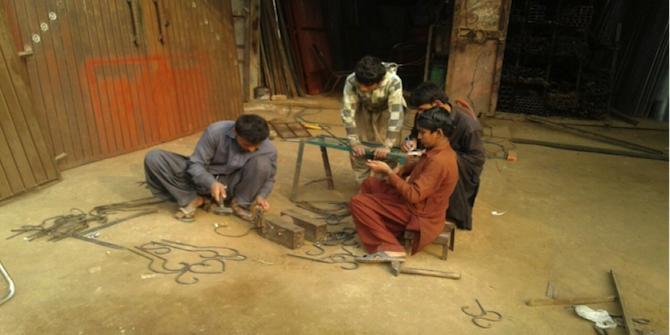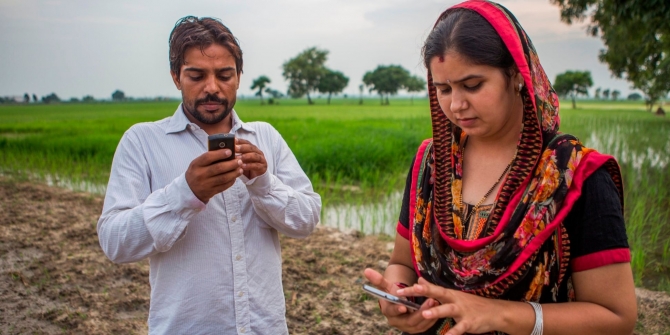 The escalating issue of boat migration in southeast Asia has been in the headlines recently following a Thai crackdown on human trafficking. Here, Mubashar Hasan argues religious schools in Bangladesh’s crime coast should be incorporated into the fight against people smugglers and traffickers.
The escalating issue of boat migration in southeast Asia has been in the headlines recently following a Thai crackdown on human trafficking. Here, Mubashar Hasan argues religious schools in Bangladesh’s crime coast should be incorporated into the fight against people smugglers and traffickers.
In light of persistent media coverage of both the refugee crisis in Europe and in southeast Asia over the past few months, the discussion of Bangladeshi and Rohingya migrants leaving their countries of origin by boat has come under the international spotlight. Within this narrative, two coastal towns of Bangladesh’s South East – namely Cox’s Bazar and Teknaf and their surrounding villages – have received special attention as areas used as hubs by people smugglers and traffickers for irregular migration via fishing boats.
This article seeks to explain the complex local socio-cultural dynamics behind the growing boat migration and suggest ways to prevent it. It argues that a bottom up approach is needed in framing a campaign against traffickers and smugglers. More specifically, the large numbers of unregulated madrasahs (religious schools) situated in Teknaf and Cox’s Bazar should be included in the campaign against human smuggling to bring about long lasting solutions.
Drivers of migration
In order to understand why Bangladeshis favour crossing seas by rickety boats, Bangladesh Institute of Social Research Trust in June 2015 conducted a field study in Cox’s Bazar and Teknaf. Some initial findings from that research have isolated two global drivers behind migration. Firstly, Bangladesh has not escaped the global trend of rising inequality, which makes it difficult for those at the bottom to live a decent quality of life. Secondly, the country is feeling the effects of climate change, which in turn leads to increased food insecurity and rural poverty. Those affected migrate to urban areas, or attempt to leave in search of employment abroad (for more on the drivers of Bangladeshi migration, see here).
The field study employed a mixed methods approach including in-depth interviews and focus group discussions with journalists, human rights defenders, law enforcement and intelligence agencies, local civil society and former people smugglers and traffickers. Some victims of trafficking who returned to Bangladesh after being held captive by traffickers and in foreign prisons and family members of some migrants who went missing in the sea were also interviewed.
The socio-economic dynamics of the hubs of people trafficking
Cox’s Bazar is Bangladesh’s prime tourist destination and it is home to many luxury hotels and resorts. It has about 125 kilometers of unbroken sandy beaches, but infrastructural underdevelopment combined with a rural landscape featuring forests, hills and unguarded seashores make it difficult for law enforcers to constantly monitor all potential departure points for people smuggling and trafficking. Teknaf is a sub district south of Cox’s Bazar and sits close to the border with Myanmar. Traditionally, before the development of tourism in the area, fishing, agriculture and salt farming were the major legal sources of income for locals, while others worked in the underground economy, for example smuggling restricted goods across the border.

The socio-economic fabric of this region has begun to change in past ten years as smuggling of a drug known as ‘Yaba’ – small pills consisting ‘highly addictive mix of methamphetamine and caffeine’ – from Myanmar became popular among local communities. Despite being a relatively a new drug it became very popular very quickly across the country and some fishermen, farmers and traders in the region were consequently drawn into a corrupt network of Yaba smuggling that now allegedly extends to some members of parliament and law enforcement. The trade has made many fishermen in Cox’s Bazar and Teknaf extremely rich. Some of them built luxurious houses in rural villages, while many whitened their black money by reinvesting in the local tourism sector. This has had two major psychological impacts within the local community, which are relevant to understand local involvement and participation in people migration and trafficking.
Firstly, some members of Yaba smuggling syndicate expanded their illegal trade into the transnational network of human traffickers. People trafficking and smuggling in this area existed before the development of the Yaba trade, but only on a very limited scale. Given the significant demand among Bangladeshis to leave in search of better prospects abroad, or else escape the effects of climate change, the illegal syndicate is able to expand into people smuggling using the existing underground set-up originally constructed for trading Yaba.
Secondly, many were tempted by the amount of wealth generated so rapidly by some Yaba smugglers. People from the local community are drawn into the smuggling and trafficking network of humans for the extra income that supplements earnings from their regular jobs as fishermen, farmers, small traders and so forth. Other groups from the local community might have no interest in participating in criminal activities but might be attracted to the option of a boat journey over the Bay of Bengal and Andaman sea provided by the sophisticated criminal gang.
What needs to be done to stop people trade?
Returning to Dhaka following the field trip, several high ranked policemen and a former law minister who is also a current member of parliament and a member of parliamentary affairs committee on Law Ministry were interviewed in order to understand what is being done to control the trade. It was found that a crackdown against traffickers and smugglers has been proving effective. However, this is likely to be a temporary solution. The government is also currently considering an option to set up special tribunals in all divisional districts to tackle the crime.
During the field trip it was found that local civil society groups took some campaign initiatives to aware people about the risk of sea migration. However, what is missing from the ongoing campaigns of both government and non-governmental bodies is a focus on the socio-psychological side of local community. The campaign needs to broaden its focus to include demotivating people from taking part in people trafficking and smuggling networks.
A major characteristic of these Muslim majority areas is that people are deeply religious and the heavy presence of privately funded unregulated madrasahs (religious schools) is hard to overlook. Influence of these madrasahs on the culture of local community is palpable. For example, during the field trip it was hard to find even young girls on their way to school without burkha and men were seen wearing tupis (traditional Muslim hats), especially in Teknaf and its surrounding villages. Most people in the fieldwork areas had been educated by the unregulated madrasahs at some point in their lives (for more on the dynamics of regulated and unregulated madrasahs in Bangladesh, see this paper by Dr Masooda Bano).
Within this spectrum, local madrasahs could play a vital role in curbing boat migration and Bangladeshi policy makers should seriously think of bringing them into the discussion of framing an effective counter-trafficking strategy. This has the potential to be effective for several reasons: first, it is a fact that madrasahs have a deeper cultural impact, especially in remote villages of Teknaf. Therefore, teachers in madrasahs could play a positive role in demotivating local people from joining criminal gangs. After all, making money by putting people in misery is the major outcome of trafficking network and this is at odds with Islamic ethics and philosophy. Second, madrasahs in Cox’s bazar and Teknaf produces thousands of religious scholars. While it is likely that these graduates may play an anti-liberal role in Bangladeshi society, it is also a fact that if the madrasah education dealt with challenges facing the local community, including the issues of trafficking and smuggling, the impact could be significant in curbing criminal activities in Teknaf and Cox’s Bazar.
In conclusion it should be noted that the proposed campaign may face two immediate challenges. First, there is an allegation raised by informed local practitioners that income generated through illegal trade in the region has been invested in erecting some religious establishments. It is a common practice in Bangladesh that even though a person may earn money in an unethical way, investing in madrasahs and mosque make the income acceptable in religious terms. Therefore it is possible that some madrasahs may resist this proposed campaign. Second, there is a long tradition that unregulated madrasahs are not open to outside intervention and it is likely that many in the area will perceive this as an attempt at outside intervention.
Nevertheless, madrasahs have a social responsibility to play and putting lives in danger for cheap money is unethical, immoral and goes against enlightened philosophy of Islam. Given that the success of anti-trafficking campaigns to date has been limited, it is worth investigating new avenues.
Note: This article gives the views of the author, and not the position of the South Asia @ LSE blog, nor of the London School of Economics. Please read our comments policy before posting.
About the Author
 Mubashar Hasan is a research fellow of BISR Trust and a PhD Candidate at the School of Government and International Relations, Griffith University, Australia. He is the founder of alochonaa.com, a politics, culture and IR blog, and tweets @mubashardhaka.
Mubashar Hasan is a research fellow of BISR Trust and a PhD Candidate at the School of Government and International Relations, Griffith University, Australia. He is the founder of alochonaa.com, a politics, culture and IR blog, and tweets @mubashardhaka.








1 Comments